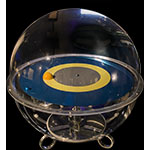Seeking a better explanation for the paths followed by the planets, Apollonius of Perga (3rd century BC) conceived of two superimposed circumferences. Along the first, concentric to the immobile Earth, the centre of the second slides smoothly at uniform speed, governing the mean motion of the planet along the zodiac. The planet proceeds at constant velocity along the second circumference (epicycle), periodically adding to or subtracting the velocity of its own motion from that of the mean motion. This explains why the planet appeared to stop and move backward periodically.
This cosmological model was later perfected by Ptolemy (2nd century AD).
Related people
Related to











